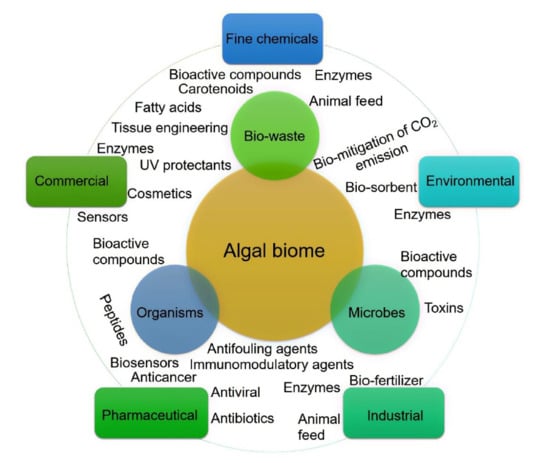State-of-the-Art Extraction Methodologies for Bioactive Compounds from Algal Biome to Meet Bio-Economy Challenges and Opportunities
Abstract
1. Introduction
2. An Immense Source of Excellent Performance: Algal Biome
- (i)
- to safeguard the natural ecosystem
- (ii)
- to circumvent or diminish the current price hike
- (iii)
- to provoke awareness on the worldwide climate issues
- (iv)
- to stimulate the greener development of regional and rural areas
- (v)
- to diminish the activities which cause greenhouse gasses emission
- (vi)
- to strengthen and diversify the bio-renewable-based energy sources
- (vii)
- to circumvent an over dependency on petrochemicals and/or petro-sources
- (viii)
- to decrease/circumvent the over-consumption of the oil, gas, coal and other potential minerals
3. Algal Biome as A Prolific Source of Bioactive Compounds
4. Conventional vs. Non-Conventional Extraction Techniques
5. Extraction Methodologies for Bioactive Compounds
5.1. Supercritical-Fluid Extraction (SFE)
Schematic Workflow of SFE
5.2. Microwave-Assisted Extraction (MAE)
Schematic Workflow of MAE
5.3. Pressurized-Liquid Extraction (PLE)
Schematic Workflow of PLE
5.4. Enzyme-Assisted Extraction (EAE)
Schematic Workflow of EAE
6. Point-of-Care Applications of Bioactive Compounds
6.1. Anticancer Potential of Algal-Based Bioactive Compounds
6.2. Antibacterial Potential of Algal-Based Bioactive Compounds
- (1)
- The genetic transformation from strain to strain.
- (2)
- Biofilm matrix forming potential of several strains.
- (3)
- Efflux pumps and other outer membrane structural variations.
- (4)
- Enzyme-mediated resistance against, in practice, antimicrobials.
- (5)
- Enhanced level of metabolic activity within the biofilm structure.
- (6)
- Lower/no perfusion of antimicrobial agents through the biofilm matrix.
- (7)
- Adaptability and interaction between antimicrobial agents and biofilm matrix.
- (8)
- Excessive/useless consumption of in practice antimicrobials in a random order.
- (9)
- Genetic variation and adaptability against excessive antimicrobials exposure.
6.3. Antiviral Potential of Algal-Based Bioactive Compounds
7. Research Gaps and Outstanding Questions
- (1)
- Is there any significant limitation to judge the proper utilization of marine sources?
- (2)
- Is there any negative impact on the ecosystem subject to the exploitation and application of marine sources?
- (3)
- Is there any approach to limit the dispersion profile and stable the bioactivity profile during extraction?
- (4)
- Is there any tactic or approach to limit the yield and stability variance when extracted from the same or multi-marine sources?
- (5)
- Is there any way to solve the particle size and composition dependent efficacy of the sample extract?
8. Concluding Remarks and Future Recommendations
Author Contributions
Funding
Acknowledgments
Conflicts of Interest
References
- Azmir, J.; Zaidul, I.S.M.; Rahman, M.M.; Sharif, K.M.; Mohamed, A.; Sahena, F.; Omar, A.K.M. Techniques for extraction of bioactive compounds from plant materials: a review. J. Food Eng. 2013, 117, 426–436. [Google Scholar] [CrossRef]
- Smith, R.M. Before the injection—Modern methods of sample preparation for separation techniques. J. Chromatogr. A 2003, 1000, 3–27. [Google Scholar] [CrossRef]
- Delattre, C.; Pierre, G.; Laroche, C.; Michaud, P. Production, extraction and characterization of microalgal and cyanobacterial exopolysaccharides. Biotechnol. Adv. 2016, 34, 1159–1179. [Google Scholar] [CrossRef] [PubMed]
- Hernández, Y.; Lobo, M.G.; González, M. Factors affecting sample extraction in the liquid chromatographic determination of organic acids in papaya and pineapple. Food Chem. 2009, 114, 734–741. [Google Scholar] [CrossRef]
- Croteau, R.; Kutchan, T.M.; Lewis, N.G. Natural products (secondary metabolites). Biochem. Mol. Biol. Plants 2000, 24, 1250–1318. [Google Scholar]
- Dewick, P.M. Secondary metabolism: the building blocks and construction mechanisms. In Medicinal Natural Products: A Biosynthetic Approach, 2nd ed.; John Wiley & Sons: Chichester, UK, 2001; pp. 7–34. [Google Scholar]
- Iqbal, H.M.N. Development of Bio-Composites with Novel Characteristics through Enzymatic Grafting. Ph.D. Thesis, University of Westminster, London, UK, 2015. Available online: https://westminsterresearch.westminster.ac.uk/item/9v61y/development-of-bio-composites-with-novel-characteristics-through-enzymatic-grafting (accessed on 4 October 2018).
- Arevalo-Gallegos, A.; Ahmad, Z.; Asgher, M.; Parra-Saldivar, R.; Iqbal, H.M. Lignocellulose: A sustainable material to produce value-added products with a zero waste approach—A review. Int. J. Biol. Macromol. 2017, 99, 308–318. [Google Scholar] [CrossRef] [PubMed]
- Centella, M.H.; Arévalo-Gallegos, A.; Parra-Saldivar, R.; Iqbal, H.M. Marine-derived bioactive compounds for value-added applications in bio-and non-bio sectors. J. Clean. Prod. 2017, 168, 1559–1565. [Google Scholar] [CrossRef]
- Bhatnagar, I.; Kim, S.K. Immense essence of excellence: marine microbial bioactive compounds. Mar. Drugs 2010, 8, 2673–2701. [Google Scholar] [CrossRef] [PubMed]
- Demirbas, A. Use of algae as biofuel sources. Energy Convers. Manag. 2010, 51, 2738–2749. [Google Scholar] [CrossRef]
- Lee, O.K.; Lee, E.Y. Sustainable production of bioethanol from renewable brown algae biomass. Biomass Bioenergy 2016, 92, 70–75. [Google Scholar] [CrossRef]
- Chee, S.Y.; Wong, P.K.; Wong, C.L. Extraction and characterisation of alginate from brown seaweeds (Fucales, Phaeophyceae) collected from Port Dickson, Peninsular Malaysia. J. Appl. Phycol. 2011, 23, 191–196. [Google Scholar] [CrossRef]
- Cock, J.M.; Godfroy, O.; Strittmatter, M.; Scornet, D.; Uji, T.; Farnham, G.; Peters, A.F.; Coelho, S.M. Emergence of Ectocarpus as a model system to study the evolution of complex multicellularity in the brown algae. In Evolutionary Transitions to Multicellular Life; Ruiz-Trillo, I., Nedelcu, A., Eds.; Advances in Marine Genomics; Springer: Dordrecht, The Netherland, 2015; Volume 2, pp. 153–162. [Google Scholar]
- Bilal, M.; Rasheed, T.; Ahmed, I.; Iqbal, H.M.N. High-value compounds from microalgae with industrial exploitability—A review. Front. Biosci. Scholar Ed. 2017, 9, 319–342. [Google Scholar]
- Macías-Sánchez, M.D.; Mantell, C.; Rodríguez, M.; Martínez de la Ossa, E.; Lubián, L.M.; Montero, O. Comparison of supercritical fluid and ultrasound-assisted extraction of carotenoids and chlorophyll a from Dunaliella salina. Talanta 2009, 77, 948–952. [Google Scholar] [CrossRef] [PubMed]
- Isnansetyo, A.; Kamei, Y. MC21-A, a bactericidal antibiotic produced by a new marine bacterium, Pseudoalteromonas phenolica sp. nov. O-BC30T, against methicillin-resistant Staphylococcus aureus. Antimicrob. Agents Chemother. 2003, 47, 480–488. [Google Scholar] [CrossRef] [PubMed]
- Mohamed, Z.A. Polysaccharides as a protective response against microcystin-induced oxidative stress in Chlorella vulgaris and Scenedesmus quadricauda and their possible significance in the aquatic ecosystem. Ecotoxicology 2008, 17, 504. [Google Scholar] [CrossRef] [PubMed]
- Brillatz, T.; Lauritano, C.; Jacmin, M.; Khamma, S.; Marcourt, L.; Righi, D.; Romano, G.; Esposito, F.; Ianora, A.; Queiroz, E.F.; et al. Zebrafish-based identification of the antiseizure nucleoside inosine from the marine diatom Skeletonema marinoi. PLoS ONE 2018, 13, e0196195. [Google Scholar] [CrossRef] [PubMed]
- Safi, C.; Camy, S.; Frances, C.; Varela, M.M.; Badia, E.C.; Pontalier, P.Y.; Vaca-Garcia, C. Extraction of lipids and pigments of Chlorella vulgaris by supercritical carbon dioxide: influence of bead milling on extraction performance. J. Appl. Phycol. 2014, 26, 1711–1718. [Google Scholar] [CrossRef]
- Li, J.; Zhu, D.; Niu, J.; Shen, S.; Wang, G. An economic assessment of astaxanthin production by large scale cultivation of Haematococcus pluvialis. Biotechnol. Adv. 2011, 29, 568–574. [Google Scholar] [CrossRef] [PubMed]
- Chatterjee, D.; Bhattacharjee, P. Supercritical carbon dioxide extraction of antioxidant rich fraction from Phormidium valderianum: Optimization of experimental process parameters. Algal Res. 2014, 3, 49–54. [Google Scholar] [CrossRef]
- Chan, M.C.; Ho, S.H.; Lee, D.J.; Chen, C.Y.; Huang, C.C.; Chang, J.S. Characterization, extraction and purification of lutein produced by an indigenous microalga Scenedesmus obliquus CNW-N. Biochem. Eng. J. 2013, 78, 24–31. [Google Scholar] [CrossRef]
- Kim, M.; Yim, J.H.; Kim, S.Y.; Kim, H.S.; Lee, W.G.; Kim, S.J.; Kang, P.S.; Lee, C.K. In vitro inhibition of influenza A virus infection by marine microalga-derived sulfated polysaccharide p-KG03. Antiviral Res. 2012, 93, 253–259. [Google Scholar] [CrossRef] [PubMed]
- Parniakov, O.; Apicella, E.; Koubaa, M.; Barba, F.J.; Grimi, N.; Lebovka, N.; Pataro, G.; Ferrari, G.; Vorobiev, E. Ultrasound-assisted green solvent extraction of high-added value compounds from microalgae Nannochloropsis spp. Bioresour. Technol. 2015, 198, 262–267. [Google Scholar] [CrossRef] [PubMed]
- Guzman, S.; Gato, A.; Lamela, M.; Freire-Garabal, M.; Calleja, J.M. Anti-inflammatory and immunomodulatory activities of polysaccharide from Chlorella stigmatophora and Phaeodactylum tricornutum. Phytother. Res. 2003, 17, 665–670. [Google Scholar] [CrossRef] [PubMed]
- Taher, H.; Al-Zuhair, S.; Al-Marzouqi, A.H.; Haik, Y.; Farid, M.; Tariq, S. Supercritical carbon dioxide extraction of microalgae lipid: process optimization and laboratory scale-up. J. Supercrit. Fluids 2014, 86, 57–66. [Google Scholar] [CrossRef]
- Adam, F.; Abert-Vian, M.; Peltier, G.; Chemat, F. “Solvent-free” ultrasound-assisted extraction of lipids from fresh microalgae cells: a green, clean and scalable process. Bioresour. Technol. 2012, 114, 457–465. [Google Scholar] [CrossRef] [PubMed]
- Dey, S.; Rathod, V.K. Ultrasound assisted extraction of β-carotene from Spirulina platensis. Ultrason. Sonochem. 2013, 20, 271–276. [Google Scholar] [CrossRef] [PubMed]
- Hahn, T.; Lang, S.; Ulber, R.; Muffler, K. Novel procedures for the extraction of fucoidan from brown algae. Process Biochem. 2012, 47, 1691–1698. [Google Scholar] [CrossRef]
- Cumashi, A.; Ushakova, N.A.; Preobrazhenskaya, M.E.; D’incecco, A.; Piccoli, A.; Totani, L.; Usov, A.I. A comparative study of the anti-inflammatory, anticoagulant, antiangiogenic, and antiadhesive activities of nine different fucoidans from brown seaweeds. Glycobiology 2007, 17, 541–552. [Google Scholar] [CrossRef] [PubMed]
- Kim, D.G.; Moon, K.; Kim, S.H.; Park, S.H.; Park, S.; Lee, S.K.; Oh, K.B.; Shin, J.; Oh, D.C. Bahamaolides A and B, antifungal polyene polyol macrolides from the marine actinomycete Streptomyces sp. J. Nat. Prod. 2012, 75, 959–967. [Google Scholar] [CrossRef] [PubMed]
- Liang, K.; Zhang, Q.; Cong, W. Enzyme-assisted aqueous extraction of lipid from microalgae. J. Agric. Food Chem. 2012, 60, 11771–11776. [Google Scholar] [CrossRef] [PubMed]
- Wang, T.; Jónsdóttir, R.; Kristinsson, H.G.; Hreggvidsson, G.O.; Jónsson, J.Ó.; Thorkelsson, G.; Ólafsdóttir, G. Enzyme-enhanced extraction of antioxidant ingredients from red algae Palmaria palmata. LWT-Food Sci. Technol. 2010, 43, 1387–1393. [Google Scholar] [CrossRef]
- Pérez, L.; Conde, E.; Domínguez, H. Microwave hydrodiffusion and gravity processing of Sargassum muticum. Process Biochem. 2014, 49, 981–988. [Google Scholar] [CrossRef]
- Kadam, S.U.; Tiwari, B.K.; O’donnell, C.P. Extraction, structure and biofunctional activities of laminarin from brown algae. Int. J. Food Sci. Technol. 2015, 50, 24–31. [Google Scholar] [CrossRef]
- Herrero, M.; Jaime, L.; Martín-Álvarez, P.J.; Cifuentes, A.; Ibáñez, E. Optimization of the extraction of antioxidants from Dunaliella salina microalga by pressurized liquids. J. Agric. Food Chem. 2006, 54, 5597–5603. [Google Scholar] [CrossRef] [PubMed]
- Kim, S.M.; Jung, Y.J.; Kwon, O.N.; Cha, K.H.; Um, B.H.; Chung, D.; Pan, C.H. A potential commercial source of fucoxanthin extracted from the microalga Phaeodactylum tricornutum. Appl. Biochem. Biotechnol. 2012, 166, 1843–1855. [Google Scholar] [CrossRef] [PubMed]
- Zuorro, A.; Miglietta, S.; Familiari, G.; Lavecchia, R. Enhanced lipid recovery from Nannochloropsis microalgae by treatment with optimized cell wall degrading enzyme mixtures. Bioresour. Technol. 2016, 212, 35–41. [Google Scholar] [CrossRef] [PubMed]
- Dejoye, C.; Vian, M.A.; Lumia, G.; Bouscarle, C.; Charton, F.; Chemat, F. Combined extraction processes of lipid from Chlorella vulgaris microalgae: microwave prior to supercritical carbon dioxide extraction. Int. J. Mol. Sci. 2011, 12, 9332–9341. [Google Scholar] [CrossRef] [PubMed]
- Deenu, A.; Naruenartwongsakul, S.; Kim, S.M. Optimization and economic evaluation of ultrasound extraction of lutein from Chlorella vulgaris. Biotechnol. Bioprocess Eng. 2013, 18, 1151–1162. [Google Scholar] [CrossRef]
- Castro-Puyana, M.; Herrero, M.; Urreta, I.; Mendiola, J.A.; Cifuentes, A.; Ibáñez, E.; Suárez-Alvarez, S. Optimization of clean extraction methods to isolate carotenoids from the microalga Neochloris oleoabundans and subsequent chemical characterization using liquid chromatography tandem mass spectrometry. Anal. Bioanal. Chem. 2013, 405, 4607–4616. [Google Scholar] [CrossRef] [PubMed]
- Simoneau, C.; Naudin, C.; Hannaert, P.; Anklam, E. Comparison of classical and alternative extraction methods for the quantitative extraction of fat from plain chocolate and the subsequent application to the detection of added foreign fats to plain chocolate formulations. Food Res. Int. 2000, 33, 733–741. [Google Scholar] [CrossRef]
- Vankar, P.S. Essential oils and fragrances from natural sources. Resonance 2004, 9, 30–41. [Google Scholar] [CrossRef]
- Umrethia, B.; Kalsariya, B.; Vaishnav, P.U. Classical and modern drug extraction techniques: Facts and figures. J. Ayurveda Integr. Med. Sci. 2017, 2, 277–283. [Google Scholar] [CrossRef]
- Dean, J.R. Extraction Techniques in Analytical Sciences; John Wiley & Sons: Hoboken, NJ, USA, 2010; Volume 34. [Google Scholar]
- García-Pérez, J.S.; Robledo-Padilla, F.; Cuellar-Bermudez, S.P.; Arévalo-Gallegos, A.; Parra-Saldivar, R.; Zavala-Yoe, R.; Iqbal, H.M.N. Thermodynamics and statistical correlation between supercritical-CO2 fluid extraction and bioactivity profile of locally available Mexican plants extracts. J. Supercrit. Fluids 2017, 122, 27–34. [Google Scholar] [CrossRef]
- Conde-Hernández, L.A.; Espinosa-Victoria, J.R.; Trejo, A.; Guerrero-Beltrán, J.Á. CO2-supercritical extraction, hydrodistillation and steam distillation of essential oil of rosemary (Rosmarinus officinalis). J. Food Eng. 2017, 200, 81–86. [Google Scholar] [CrossRef]
- Arranz, E.; Jaime, L.; de las Hazas, M.L.; Reglero, G.; Santoyo, S. Supercritical fluid extraction as an alternative process to obtain essential oils with anti-inflammatory properties from marjoram and sweet basil. Ind. Crops Prod. 2015, 67, 121–129. [Google Scholar] [CrossRef]
- Maran, J.P.; Priya, B. Supercritical fluid extraction of oil from muskmelon (Cucumis melo) seeds. J. Taiwan Inst. Chem. Eng. 2015, 47, 71–78. [Google Scholar] [CrossRef]
- Zacconi, F.C.; Cabrera, A.L.; Ordonez-Retamales, F.; del Valle, J.M.; Juan, C. Isothermal solubility in supercritical carbon dioxide of solid derivatives of 2, 3-dichloronaphthalene-1, 4-dione (dichlone): 2-(Benzylamino)-3-chloronaphthalene-1, 4-dione and 2-chloro-3-(phenethylamino) naphthalene-1, 4-dione. J. Supercrit. Fluids 2017, 129, 75–82. [Google Scholar] [CrossRef]
- García-Pérez, J.S.; Cuéllar-Bermúdez, S.P.; Arévalo-Gallegos, A.; Salinas-Salazar, C.; Rodríguez-Rodríguez, J.; de la Cruz-Quiroz, R.; Iqbal, H.M.N.; Parra-Saldívar, R. Influence of Supercritical CO2 Extraction on Fatty Acids Profile, Volatile Compounds and Bioactivities from Rosmarinus officinalis. Waste Biomass Valorization 2018, 1–11. [Google Scholar] [CrossRef]
- Roodpeyma, M.; Guigard, S.E.; Stiver, W.H. Pressure control of a continuous pilot scale supercritical fluid extraction (SFE) process. J. Supercrit. Fluids 2018, 135, 120–129. [Google Scholar] [CrossRef]
- García-Pérez, J.S.; Cuéllar-Bermúdez, S.P.; Arévalo-Gallegos, A.; Rodríguez-Rodríguez, J.; Iqbal, H.M.N.; Parra-Saldivar, R. Identification of bioactivity, volatile and fatty acid profile in supercritical fluid extracts of Mexican arnica. Int. J. Mol. Sci. 2016, 17, 1528. [Google Scholar] [CrossRef] [PubMed]
- Capuzzo, A.; Maffei, M.E.; Occhipinti, A. Supercritical fluid extraction of plant flavors and fragrances. Molecules 2013, 18, 7194–7238. [Google Scholar] [CrossRef] [PubMed]
- Núñez, G.A.; del Valle, J.M.; Navia, D. Supercritical CO2 oilseed extraction in multi-vessel plants. 3. Effect of extraction pressure and plant size on production cost. J. Supercrit. Fluids 2017, 122, 109–118. [Google Scholar] [CrossRef]
- Crespi, F.; Gavagnin, G.; Sánchez, D.; Martínez, G.S. Analysis of the Thermodynamic Potential of Supercritical Carbon Dioxide Cycles: A Systematic Approach. J. Eng. Gas Turbines Power 2018, 140, 051701. [Google Scholar] [CrossRef]
- Carissimi, G.; Montalbán, M.G.; Baños, F.G.D.; Víllora, G. High pressure phase equilibria for binary mixtures of CO2 + 2-pentanol, vinyl butyrate, 2-pentyl butyrate or butyric acid systems. J. Supercrit. Fluids 2018, 135, 69–77. [Google Scholar] [CrossRef]
- Paula, J.T.; Sousa, I.M.; Foglio, M.A.; Cabral, F.A. Selective fractionation of extracts of Arrabidaea chica Verlot using supercritical carbon dioxide as antisolvent. J. Supercrit. Fluids 2018, 133, 9–16. [Google Scholar] [CrossRef]
- Botelho, J.R.S.; Santos, A.G.; Araújo, M.E.; Braga, M.E.M.; Gomes-Leal, W.; Junior, R.N.C.; Oliveira, M.S. Copaíba (Copaifera sp.) leaf extracts obtained by CO2 supercritical fluid extraction: Isotherms of global yield, kinetics data, antioxidant activity and neuroprotective effects. J. Supercrit. Fluids 2015, 98, 167–171. [Google Scholar] [CrossRef]
- Corzzini, S.C.; Barros, H.D.; Grimaldi, R.; Cabral, F.A. Extraction of edible avocado oil using supercritical CO2 and a CO2/ethanol mixture as solvents. J. Food Eng. 2017, 194, 40–45. [Google Scholar] [CrossRef]
- De Melo, M.M.R.; Şen, A.; Silvestre, A.J.; Pereira, H.; Silva, C.M. Experimental and modeling study of supercritical CO2 extraction of Quercus cerris cork: Influence of ethanol and particle size on extraction kinetics and selectivity to friedelin. Sep. Purif. Technol. 2017, 187, 34–45. [Google Scholar] [CrossRef]
- Chen, H.H.; Chung, C.C.; Wang, H.Y.; Huang, T.C. Application of Taguchi method to optimize extracted ginger oil in different drying conditions. IPCBEE May 2011, 9, 310–316. [Google Scholar]
- Sharif, K.M.; Rahman, M.M.; Azmir, J.; Mohamed, A.; Jahurul, M.H.A.; Sahena, F.; Zaidul, I.S.M. Experimental design of supercritical fluid extraction—A review. J. Food Eng. 2014, 124, 105–116. [Google Scholar] [CrossRef]
- Mendiola, J.A.; Santoyo, S.; Cifuentes, A.; Reglero, G.; Ibanez, E.; Señoráns, F.J. Antimicrobial activity of sub-and supercritical CO2 extracts of the green alga Dunaliella salina. J. Food Prot. 2008, 71, 2138–2143. [Google Scholar] [CrossRef] [PubMed]
- Mendiola, J.A.; Marín, F.R.; Hernández, S.F.; Arredondo, B.O.; Señoráns, F.J.; Ibañez, E.; Reglero, G. Characterization via liquid chromatography coupled to diode array detector and tandem mass spectrometry of supercritical fluid antioxidant extracts of Spirulina platensis microalga. J. Sep. Sci. 2005, 28, 1031–1038. [Google Scholar] [CrossRef] [PubMed]
- Mendiola, J.A.; García-Martínez, D.; Rupérez, F.J.; Martín-Álvarez, P.J.; Reglero, G.; Cifuentes, A.; Señoráns, F.J. Enrichment of vitamin E from Spirulina platensis microalga by SFE. J. Supercrit. Fluids 2008, 43, 484–489. [Google Scholar] [CrossRef]
- Mendes, R.L.; Nobre, B.P.; Cardoso, M.T.; Pereira, A.P.; Palavra, A.F. Supercritical carbon dioxide extraction of compounds with pharmaceutical importance from microalgae. Inorg. Chim. Acta 2003, 356, 328–334. [Google Scholar] [CrossRef]
- Wang, S.Y.; Yang, L.; Zu, Y.G.; Zhao, C.J.; Sun, X.W.; Zhang, L.; Zhang, Z.H. Design and performance evaluation of ionic-liquids-based microwave-assisted environmentally friendly extraction technique for camptothecin and 10-hydroxycamptothecin from samara of camptotheca acuminata. Ind. Eng. Chem. Res. 2011, 50, 13620–13627. [Google Scholar] [CrossRef]
- Ma, C.H.; Yang, L.; Zu, Y.G.; Liu, T.T. Optimization of conditions of solvent-free microwave extraction and study on antioxidant capacity of essential oil from Schisandra chinensis (Turcz.) Baill. Food Chem. 2012, 134, 2532–2539. [Google Scholar] [CrossRef] [PubMed]
- Martino, E.; Ramaiola, I.; Urbano, M.; Bracco, F.; Collina, S. Microwave-assisted extraction of coumarin and related compounds from Melilotus officinalis (L.) Pallas as an alternative to Soxhlet and ultrasound-assisted extraction. J. Chromatogr. A 2006, 1125, 147–151. [Google Scholar] [CrossRef] [PubMed]
- Wang, L.; Weller, C.L. Recent advances in extraction of nutraceuticals from plants. Trends Food Sci. Technol. 2006, 17, 300–312. [Google Scholar] [CrossRef]
- Alam, M.; Sarker, M.; Ghafoor, K.; Happy, R.A.; Ferdosh, S. Bioactive Compounds and Extraction Techniques. Recover. Bioactive Compounds Agric. Wastes 2017, 33–53. [Google Scholar] [CrossRef]
- Uy, S.F.; Easteal, A.J.; Farid, M.M.; Keam, R.B.; Conner, G.T. Seaweed processing using industrial single-mode cavity microwave heating: a preliminary investigation. Carbohydr. Res. 2005, 340, 1357–1364. [Google Scholar] [CrossRef] [PubMed]
- Navarro, D.A.; Flores, M.L.; Stortz, C.A. Microwave-assisted desulfation of sulfated polysaccharides. Carbohydr. Polym. 2007, 69, 742–747. [Google Scholar] [CrossRef]
- Chhatbar, M.; Meena, R.; Prasad, K.; Siddhanta, A.K. Microwave assisted rapid method for hydrolysis of sodium alginate for M/G ratio determination. Carbohydr. Polym. 2009, 76, 650–656. [Google Scholar] [CrossRef]
- Sousa, A.M.; Alves, V.D.; Morais, S.; Delerue-Matos, C.; Gonçalves, M.P. Agar extraction from integrated multitrophic aquacultured Gracilaria vermiculophylla: Evaluation of a microwave-assisted process using response surface methodology. Bioresour. Technol. 2010, 101, 3258–3267. [Google Scholar] [CrossRef] [PubMed]
- Rodriguez-Jasso, R.M.; Mussatto, S.I.; Pastrana, L.; Aguilar, C.N.; Teixeira, J.A. Microwave-assisted extraction of sulfated polysaccharides (fucoidan) from brown seaweed. Carbohydr. Polym. 2011, 86, 1137–1144. [Google Scholar] [CrossRef]
- Yuan, Y.; Macquarrie, D. Microwave assisted extraction of sulfated polysaccharides (fucoidan) from Ascophyllum nodosum and its antioxidant activity. Carbohydr. Polym. 2015, 129, 101–107. [Google Scholar] [CrossRef] [PubMed]
- Ying, Z.; Han, X.; Li, J. Ultrasound-assisted extraction of polysaccharides from mulberry leaves. Food Chem. 2011, 127, 1273–1279. [Google Scholar] [CrossRef] [PubMed]
- Letellier, M.; Budzinski, H. Microwave assisted extraction of organic compounds. Analusis 1999, 27, 259–270. [Google Scholar] [CrossRef]
- Letellier, M.; Budzinski, H.; Charrier, L.; Capes, S.; Dorthe, A.M. Optimization by factorial design of focused microwave assisted extraction of polycyclic aromatic hydrocarbons from marine sediment. Fresenius J. Anal. Chem. 1999, 364, 228–237. [Google Scholar] [CrossRef]
- Mandal, V.; Mohan, Y.; Hemalatha, S. Microwave assisted extraction—an innovative and promising extraction tool for medicinal plant research. Pharmacogn. Rev. 2007, 1, 7–18. [Google Scholar]
- Kaufmann, B.; Christen, P. Recent extraction techniques for natural products: microwave-assisted extraction and pressurised solvent extraction. Phytochem. Anal. 2002, 13, 105–113. [Google Scholar] [CrossRef] [PubMed]
- Richter, B.E.; Jones, B.A.; Ezzell, J.L.; Porter, N.L.; Avdalovic, N.; Pohl, C. Accelerated solvent extraction: A technique for sample preparation. Anal. Chem. 1996, 68, 1033–1039. [Google Scholar] [CrossRef]
- Nieto, A.; Borrull, F.; Pocurull, E.; Marcé, R.M. Pressurized liquid extraction: a useful technique to extract pharmaceuticals and personal-care products from sewage sludge. TrAC Trends Anal. Chem. 2010, 29, 752–764. [Google Scholar] [CrossRef]
- Tang, S.Y.; Bourne, R.A.; Smith, R.L.; Poliakoff, M. The 24 principles of green engineering and green chemistry: “IMPROVEMENTS PRODUCTIVELY”. Green Chem. 2008, 10, 268–269. [Google Scholar] [CrossRef]
- Otero, P.; Quintana, S.E.; Reglero, G.; Fornari, T.; García-Risco, M.R. Pressurized Liquid Extraction (PLE) as an Innovative Green Technology for the Effective Enrichment of Galician Algae Extracts with High Quality Fatty Acids and Antimicrobial and Antioxidant Properties. Mari. Drugs 2018, 16, 156. [Google Scholar] [CrossRef] [PubMed]
- Shang, Y.F.; Kim, S.M.; Lee, W.J.; Um, B.H. Pressurized liquid method for fucoxanthin extraction from Eisenia bicyclis (Kjellman) Setchell. J. Biosci. Bioeng. 2011, 111, 237–241. [Google Scholar] [CrossRef] [PubMed]
- Anaëlle, T.; Leon, E.S.; Laurent, V.; Elena, I.; Mendiola, J.A.; Stéphane, C.; Valérie, S.P. Green improved processes to extract bioactive phenolic compounds from brown macroalgae using Sargassum muticum as model. Talanta 2013, 104, 44–52. [Google Scholar] [CrossRef] [PubMed]
- Fleurence, J.; Massiani, L.; Guyader, O.; Mabeau, S. Use of enzymatic cell wall degradation for improvement of protein extraction from Chondrus crispus, Gracilaria verrucosa and Palmaria palmata. J. Appl. Phycol. 1995, 7, 393. [Google Scholar] [CrossRef]
- Shen, L.; Wang, X.; Wang, Z.; Wu, Y.; Chen, J. Studies on tea protein extraction using alkaline and enzyme methods. Food Chem. 2008, 107, 929–938. [Google Scholar] [CrossRef]
- Kim, S.K. Handbook of Marine Macroalgae: Biotechnology and Applied Phycology; John Wiley & Sons: Hoboken, NJ, USA, 2011. [Google Scholar]
- Rosenthal, A.; Pyle, D.L.; Niranjan, K. Aqueous and enzymatic processes for edible oil extraction. Enzyme Microb. Technol. 1996, 19, 402–420. [Google Scholar] [CrossRef]
- Barzana, E.; Rubio, D.; Santamaria, R.I.; Garcia-Correa, O.; Garcia, F.; Ridaura Sanz, V.E.; López-Munguía, A. Enzyme-mediated solvent extraction of carotenoids from marigold flower (Tagetes erecta). J. Agric. Food Chem. 2002, 50, 4491–4496. [Google Scholar] [CrossRef] [PubMed]
- Roufik, S.; Gauthier, S.F.; Turgeon, S.L. In vitro digestibility of bioactive peptides derived from bovine β-lactoglobulin. Int. Dairy J. 2006, 16, 294–302. [Google Scholar] [CrossRef]
- del Pilar Sánchez-Camargo, A.; Montero, L.; Stiger-Pouvreau, V.; Tanniou, A.; Cifuentes, A.; Herrero, M.; Ibáñez, E. Considerations on the use of enzyme-assisted extraction in combination with pressurized liquids to recover bioactive compounds from algae. Food Chem. 2016, 192, 67–74. [Google Scholar] [CrossRef] [PubMed]
- Puri, M.; Sharma, D.; Barrow, C.J. Enzyme-assisted extraction of bioactives from plants. Trends Biotechnol. 2012, 30, 37–44. [Google Scholar] [CrossRef] [PubMed]
- Latif, S.; Anwar, F. Physicochemical studies of hemp (Cannabis sativa) seed oil using enzyme-assisted cold-pressing. Eur. J. Lipid Sci. Technol. 2009, 111, 1042–1048. [Google Scholar] [CrossRef]
- Dunford, N.T.; Dunford, H.B. Nutritionally Enhanced Edible Oil Processing, 1st ed.; AOCS Publishing: New York, NY, USA, 2004. [Google Scholar]
- Bhattacharjee, P.; Singhal, R.S.; Tiwari, S.R. Supercritical carbon dioxide extraction of cottonseed oil. J. Food Eng. 2007, 79, 892–898. [Google Scholar] [CrossRef]
- Galanakis, C.M. Nutraceutical and Functional Food Components: Effects of Innovative Processing Techniques; Academic Press: Waltham, MA, USA, 2017; Chapter 1; pp. 1–14. [Google Scholar]
- Agyei, D.; Ahmed, I.; Akram, Z.; Iqbal, H.M.N.; Danquah, M.K. Protein and peptide biopharmaceuticals: An overview. Protein Pept. Lett. 2017, 24, 94–101. [Google Scholar] [CrossRef] [PubMed]
- Chandra, R.; Parra, R.; Iqbal, H.M.N. Phycobiliproteins: A Novel Green Tool from Marine Origin Blue-Green Algae and Red Algae. Protein Pept. Lett. 2017, 24, 118–125. [Google Scholar] [CrossRef] [PubMed]
- Ruiz-Ruiz, F.M.; Mancera-Andrade, E.I.; Iqbal, H.M.N. Marine-derived bioactive peptides for biomedical sectors-a review. Protein Pept. Lett. 2017, 24, 109–117. [Google Scholar] [CrossRef] [PubMed]
- Stewart, B.W.; Wild, C.P. World Cancer Report 2014: IARC Nonserial Publication; World Health Organization: Geneva, Switzerland, 2014; Volume 2014, p. 630. [Google Scholar]
- Suarez-Jimenez, G.M.; Burgos-Hernandez, A.; Ezquerra-Brauer, J.M. Bioactive peptides and depsipeptides with anticancer potential: Sources from marine animals. Mar. Drugs 2012, 10, 963–986. [Google Scholar] [CrossRef] [PubMed]
- Malaker, A.; Ahmad, S.A.I. Therapeutic potency of anticancer peptides derived from marine organism. Int. J. Eng. 2013, 2, 2305–8269. [Google Scholar]
- Zheng, L.H.; Wang, Y.J.; Sheng, J.; Wang, F.; Zheng, Y.; Lin, X.K.; Sun, M. Antitumor peptides from marine organisms. Mar. Drugs 2011, 9, 1840–1859. [Google Scholar] [CrossRef] [PubMed]
- Kwak, J.Y. Fucoidan as a marine anticancer agent in preclinical development. Mar. Drugs 2014, 12, 851–870. [Google Scholar] [CrossRef] [PubMed]
- Somasundaram, S.N.; Shanmugam, S.; Subramanian, B.; Jaganathan, R. Cytotoxic effect of fucoidan extracted from Sargassum cinereum on colon cancer cell line HCT-15. Int. J. Biol. Macromol. 2016, 91, 1215–1223. [Google Scholar] [CrossRef] [PubMed]
- Anastyuk, S.D.; Shevchenko, N.M.; Usoltseva (Menshova), R.V.; Silchenko, A.S.; Zadorozhny, P.A.; Dmitrenok, P.S.; Ermakova, S.P. Structural features and anticancer activity in vitro of fucoidan derivatives from brown alga Saccharina cichorioides. Carbohydr. Polym. 2017, 157, 1503–1510. [Google Scholar] [CrossRef] [PubMed]
- Zhang, Z.; Teruya, K.; Yoshida, T.; Eto, H.; Shirahata, S. Fucoidan extract enhances the anti-cancer activity of chemotherapeutic agents in MDA-MB-231 and MCF-7 breast cancer cells. Mar. Drugs 2013, 11, 81–98. [Google Scholar] [CrossRef] [PubMed]
- Pawar, V.K.; Singh, Y.; Sharma, K.; Shrivastav, A.; Sharma, A.; Singh, A.; Bora, H.K. Improved chemotherapy against breast cancer through immunotherapeutic activity of fucoidan decorated electrostatically assembled nanoparticles bearing doxorubicin. Int. J. Biol. Macromol. 2018. [Google Scholar] [CrossRef] [PubMed]
- Song, Y.; Wang, Q.; Wang, Q.; He, Y.; Ren, D.; Liu, S.; Wu, L. Structural characterization and antitumor effects of fucoidans from brown algae Kjellmaniella crassifolia farmed in northern China. Int. J. Biol. Macromol. 2018, 119, 125–133. [Google Scholar] [CrossRef] [PubMed]
- Hsu, H.Y.; Lin, T.Y.; Hu, C.H.; Shu, D.T.F.; Lu, M.K. Fucoidan Upregulates TLR4/CHOP-Mediated Caspase-3 and PARP Activation to Enhance Cisplatin-Induced Cytotoxicity in Human Lung Cancer Cells. Cancer Lett. 2018, 432, 112–120. [Google Scholar] [CrossRef] [PubMed]
- Tsai, H.L.; Tai, C.J.; Huang, C.W.; Chang, F.R.; Wang, J.Y. Efficacy of low-molecular-weight fucoidan as a supplemental therapy in metastatic colorectal cancer patients: A double-blind randomized controlled trial. Mar. Drugs 2017, 15, 122. [Google Scholar] [CrossRef] [PubMed]
- Bilal, M.; Rasheed, T.; Iqbal, H.M.N.; Hu, H.; Wang, W.; Zhang, X. Macromolecular agents with antimicrobial potentialities: A drive to combat antimicrobial resistance. Int. J. Biol. Macromol. 2017, 103, 554–574. [Google Scholar] [CrossRef] [PubMed]
- Taskin, E.; Ozturk, M.; Kurt, O. Antibacterial activities of some marine algae from the Aegean Sea (Turkey). Afr. J. Biotechnol. 2007, 6, 2746–2751. [Google Scholar]
- Bansemir, A.; Blume, M.; Schröder, S.; Lindequist, U. Screening of cultivated seaweeds for antibacterial activity against fish pathogenic bacteria. Aquaculture 2006, 252, 79–84. [Google Scholar] [CrossRef]
- Lee, K.Y.; Jeong, M.R.; Choi, S.M.; Na, S.S.; Cha, J.D. Synergistic effect of fucoidan with antibiotics against oral pathogenic bacteria. Arch. Oral Biol. 2013, 58, 482–492. [Google Scholar] [CrossRef] [PubMed]
- Shannon, E.; Abu-Ghannam, N. Antibacterial derivatives of marine algae: An overview of pharmacological mechanisms and applications. Mar. Drugs 2016, 14, 81. [Google Scholar] [CrossRef] [PubMed]
- Iqbal, H.M.N. The Quest for Materials-Based Hydrogels with Antimicrobial and Antiviral Potentialities. Open Virol. J. 2018, 12, 69–79. [Google Scholar] [CrossRef] [PubMed]
- Nijhuis, M.; Van Maarseveen, N.M.; Boucher, C.A.B. Antiviral Resistance and Impact on Viral Replication Capacity: Evolution of Viruses Under Antiviral Pressure Occurs in Three Phases. In Antiviral Strategies. Handbook of Experimental Pharmacology; Kräusslich, H.G., Bartenschlager, R., Eds.; Springer: Berlin/Heidelberg, Germany, 2009; Volume 189, pp. 299–300. [Google Scholar]
- Herlocher, M.L.; Truscon, R.; Elias, S.; Yen, H.L.; Roberts, N.A.; Ohmit, S.E.; Monto, A.S. Influenza viruses resistant to the antiviral drug oseltamivir: transmission studies in ferrets. J. Infect. Dis. 2004, 190, 1627–1630. [Google Scholar] [CrossRef] [PubMed]
- WHO. Antiviral Use and the Risk of Drug Resistance. Pandemic (H1N1) 2009 Briefing Note 12. 2009. Available online: http://www.who.int/csr/disease/swineflu/notes/h1n1_antiviral_use_20090925/en (accessed on 10 September 2018).
- Borowitzka, M.A. Microalgae as sources of pharmaceuticals and other biologically active compounds. J. Appl. Phycol. 1995, 7, 3–15. [Google Scholar] [CrossRef]
- Guedes, A.C.; Amaro, H.M.; Malcata, F.X. Microalgae as sources of high added-value compounds—A brief review of recent work. Biotechnol. Progr. 2011, 27, 597–613. [Google Scholar] [CrossRef] [PubMed]
- Rizwan, M.; Mujtaba, G.; Memon, S.A.; Lee, K.; Rashid, N. Exploring the potential of microalgae for new biotechnology applications and beyond: A review. Renew. Sustain. Energy Rev. 2018, 92, 394–404. [Google Scholar] [CrossRef]
- Gustafson, K.R.; Cardellina, J.H.; Fuller, R.W.; Weislow, O.S.; Kiser, R.F.; Snader, K.M.; Patterson, G.M.L.; Boyd, M.R. AIDS-antiviral sulfolipids from cyanobacteria (blue-green algae). J. Natl. Cancer Inst. 1989, 81, 1254–1258. [Google Scholar] [CrossRef] [PubMed]
- Singh, S.; Kate, B.N.; Banerjee, U.C. Bioactive compounds from cyanobacteria and microalgae: An overview. Crit. Rev. Biotechnol. 2005, 25, 73–95. [Google Scholar] [CrossRef] [PubMed]
- Yang, F.; Bewley, C.A.; Louis, J.M.; Gustafson, K.R.; Boyd, M.R.; Gronenborn, A.M.; Wlodawer, A. Crystal structure of cyanovirin-N, a potent HIV-inactivating protein, shows unexpected domain swapping 1. J. Mol. Biol. 1999, 288, 403–412. [Google Scholar] [CrossRef] [PubMed]
- Hayashi, K.; Hayashi, T.; Kojima, I. A natural sulfated polysaccharide, calcium spirulan, isolated from Spirulina platensis: In vitro and ex vivo evaluation of anti-herpes simplex virus and anti-human immunodeficiency virus activities. AIDS Res. Hum. Retroviruses 1996, 12, 1463–1471. [Google Scholar] [CrossRef] [PubMed]
- Hayashi, T.; Hayashi, K.; Maeda, M.; Kojima, I. Calcium spirulan, an inhibitor of enveloped virus replication, from a blue-green alga Spirulina platensis. J. Nat. Prod. 1996, 59, 83–87. [Google Scholar] [CrossRef] [PubMed]
- Ayehunie, S.; Belay, A.; Baba, T.W.; Ruprecht, R.M. Inhibition of HIV-1 replication by an aqueous extract of Spirulina platensis (Arthrospira platensis). J. Acquir. Immune Defic. Syndr. Hum. Retrovirol. 1998, 18, 7–12. [Google Scholar] [CrossRef] [PubMed]
- Dey, B.; Lerner, D.L.; Lusso, P.; Boyd, M.R.; Elder, J.H.; Berger, E.A. Multiple antiviral activities of cyanovirin-N: blocking of human immunodeficiency virus type 1 gp120 interaction with CD4 and coreceptor and inhibition of diverse enveloped viruses. J. Virol. 2000, 74, 4562–4569. [Google Scholar] [CrossRef] [PubMed]
- Huleihel, M.; Ishanu, V.; Tal, J.; Arad, S.M. Antiviral effect of red microalgal polysaccharides on Herpes simplex and Varicella zoster viruses. J. Appl. Phycol. 2001, 13, 127–134. [Google Scholar] [CrossRef]

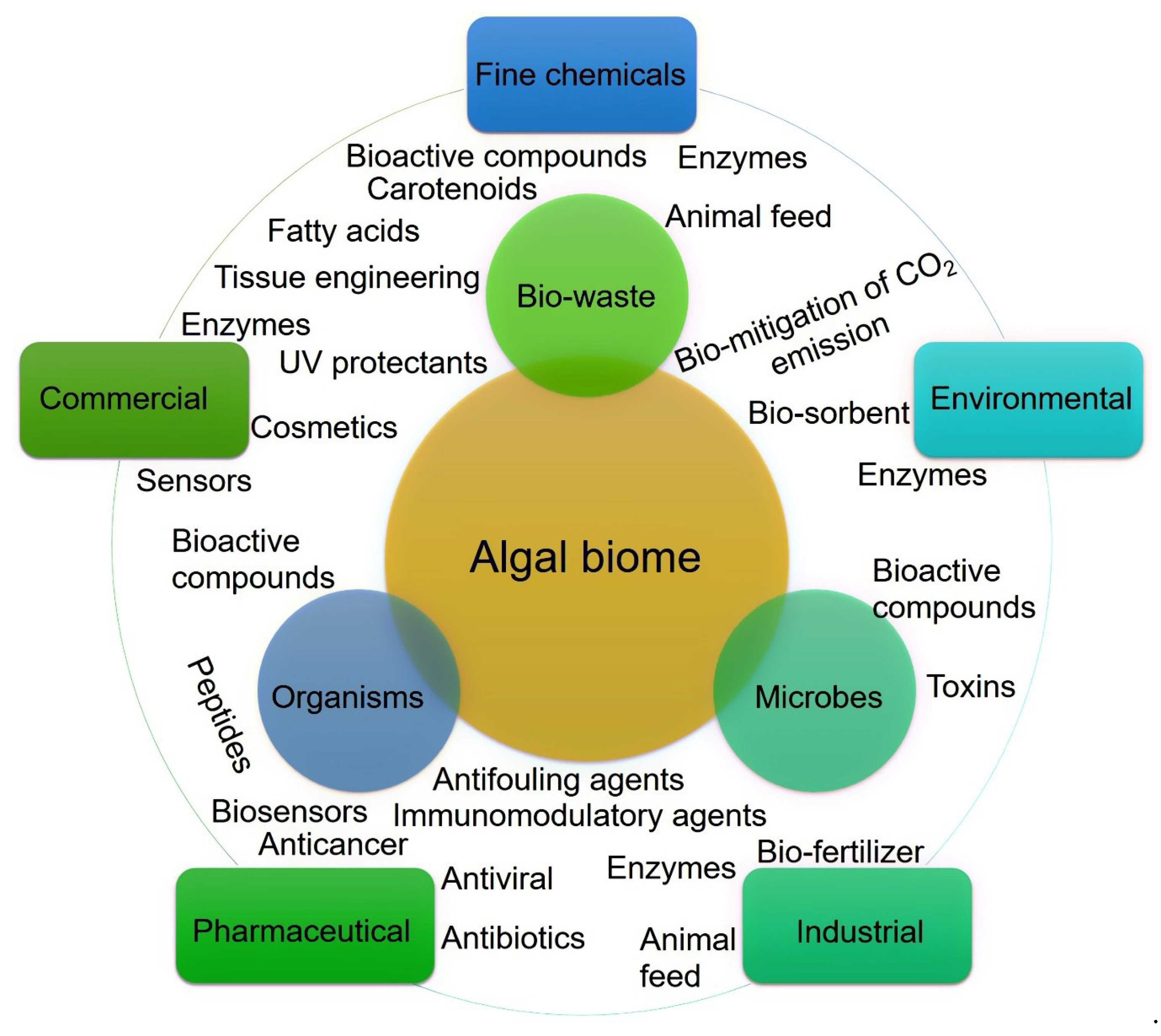
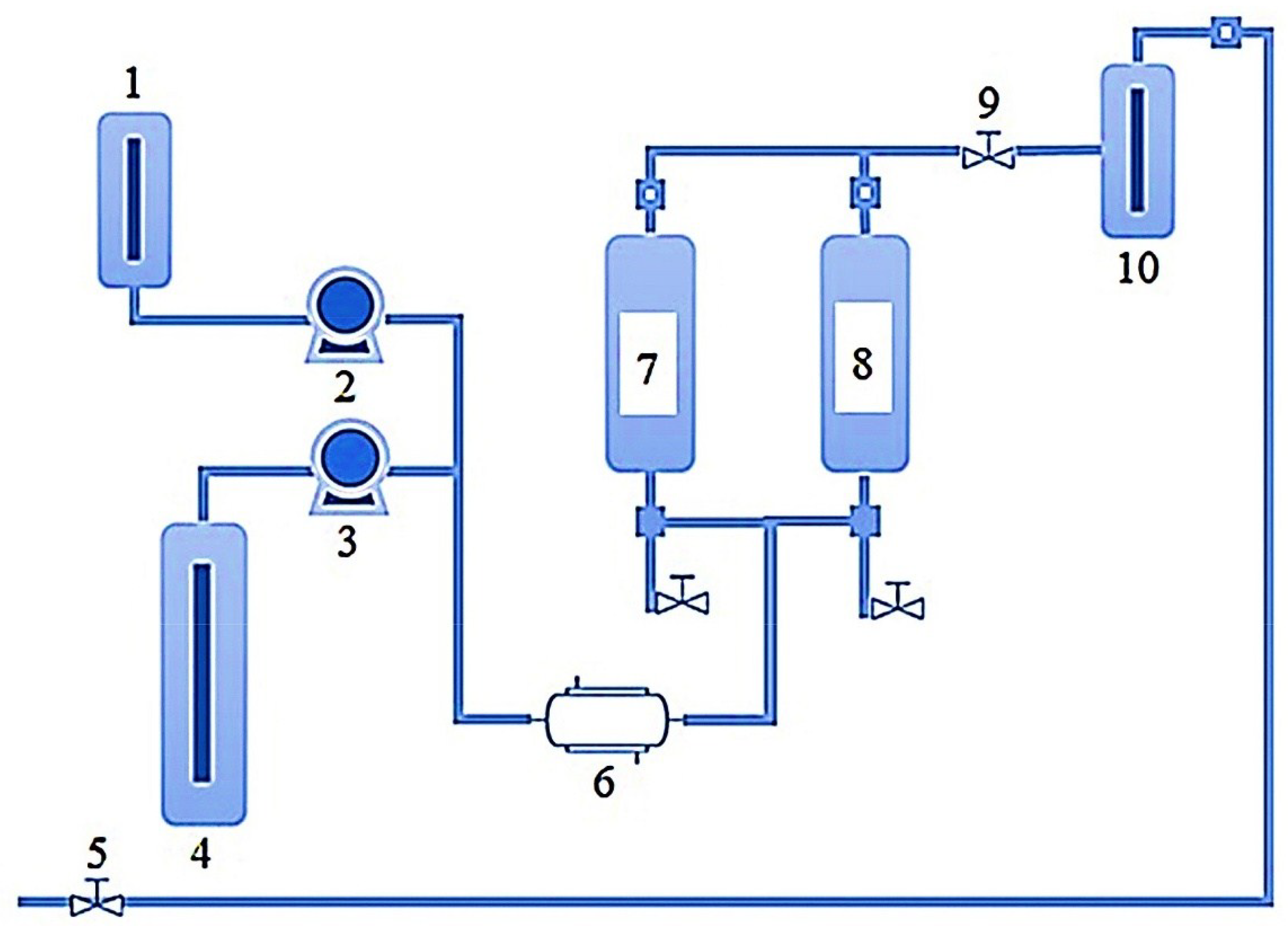
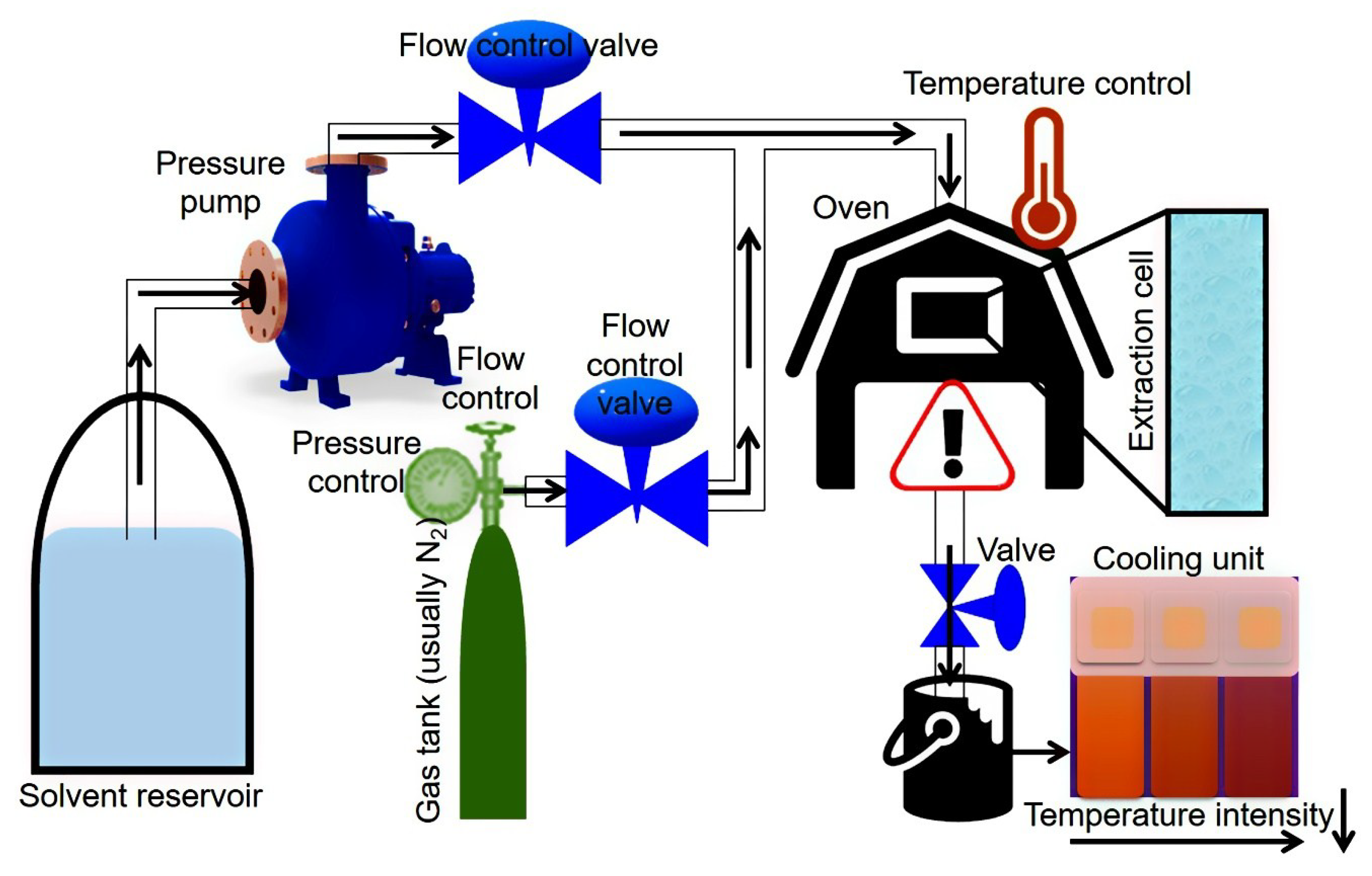
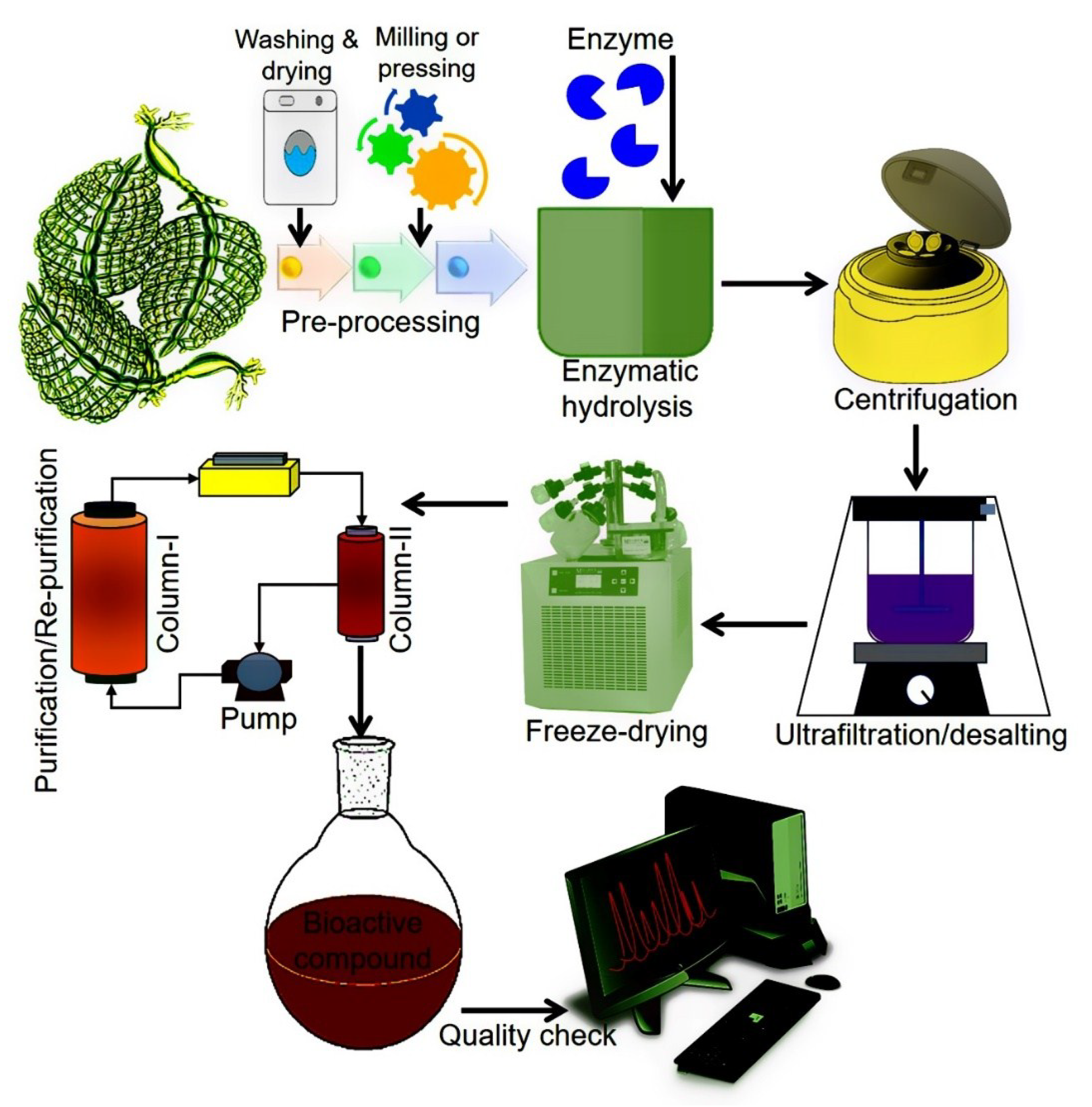

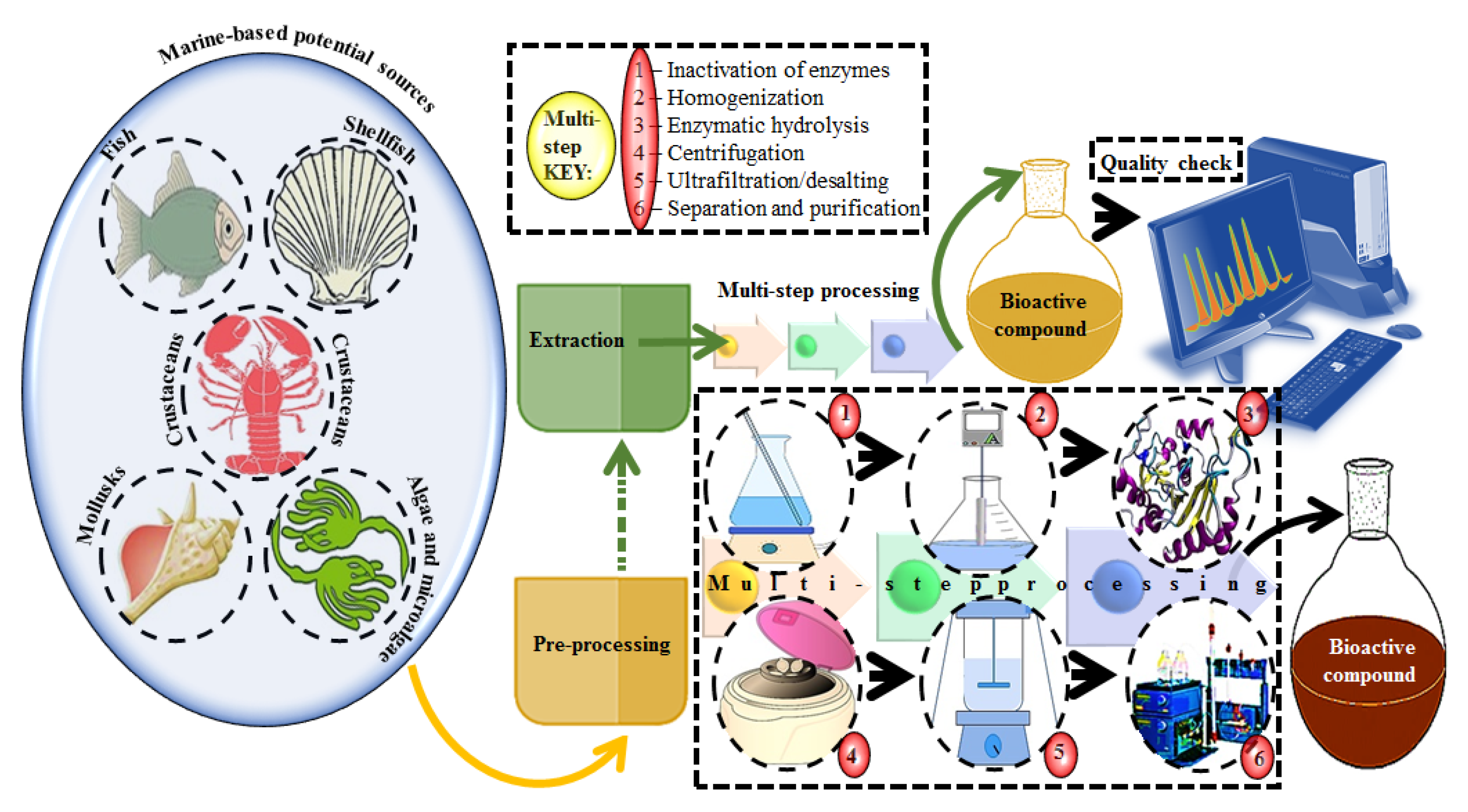
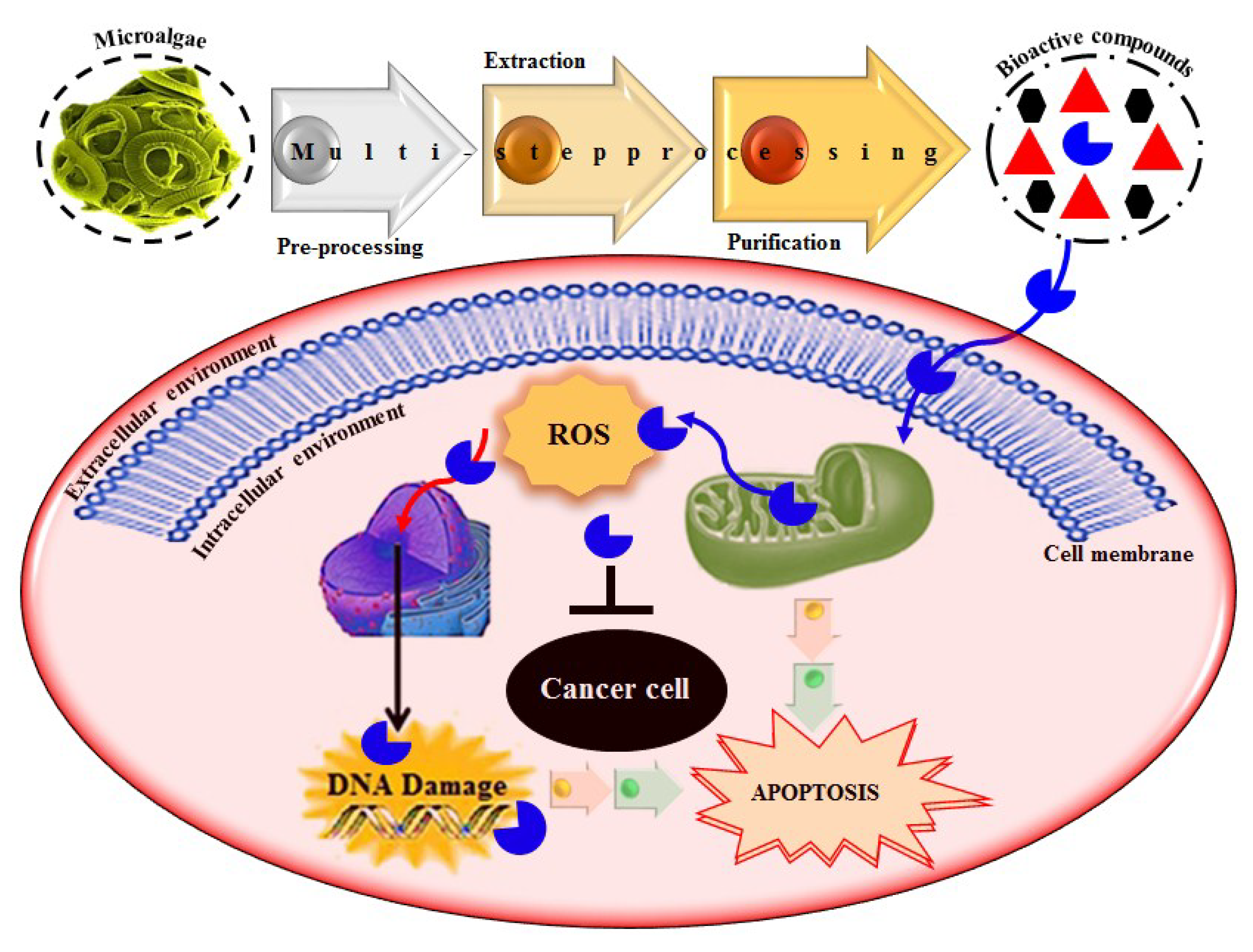
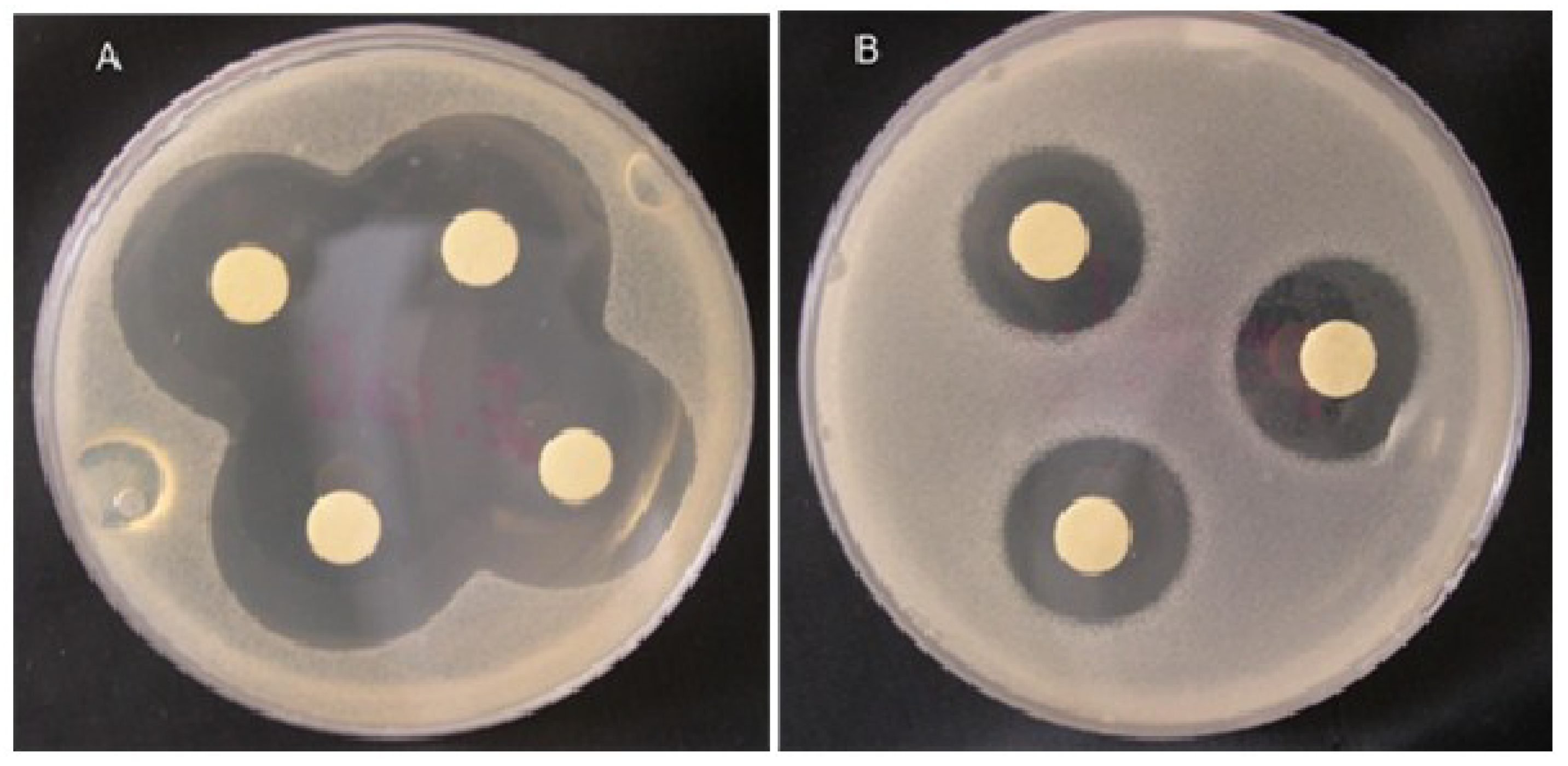
| Algal spp. | Bioactive Compound | Structure | Methodology | Reference |
|---|---|---|---|---|
| Dunaliella salina | Carotenoids (β-carotene), Chlorophyll a and b | 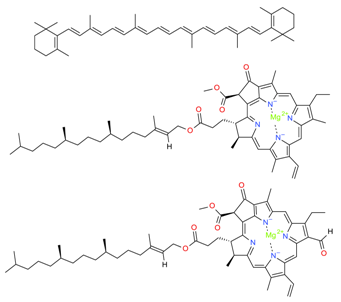 | SFE, UAE | Macías-Sánchez et al. [16] |
| Pseudoalteromonas phenolica | MC21-A |  | Solvent extraction methanol | Isnansetyo and Kamei [17] |
| Chlorella vulgaris Scenedesmus quadricauda | Antioxidant polysaccharides (sulfated polysaccharides) | 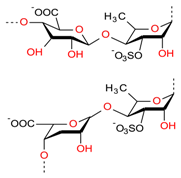 | EAE | Mohamed [18] |
| Skeletonema marinoi | Anticonvulsant inosine |  | Solvent extraction | Brillatz et al. [19] |
| Chlorella vulgaris | Carotenoids (β-carotene), Chlorophyll a and b |  | SFE | Safi et al. [20] |
| Haematococcus pluvialis | Astaxanthin |  | SFE | Li et al. [21] |
| Phormidium valderianum | Anatoxin-a |  | SFE | Chatterjee and Bhattacharjee [22] |
| Scenedesmus obliquus | Lutein |  | Solvent extraction, UAE | Chan et al. [23] |
| Gyrodinium impudium | Sulfated polysaccharide | 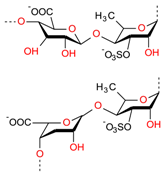 | Solvent extraction | Kim et al. [24] |
| Nannochloropsis spp. | Carotenoids (β-carotene), Chlorophyll a and b | 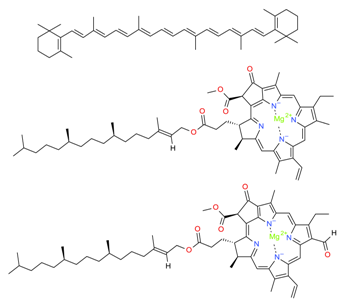 | UAE | Parniakov et al. [25] |
| Chlorella stigmatophora Phaeodactylum tricornutum | Crude polysaccharide extracts | 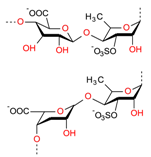 | Lyophilized | Guzmán et al. [26] |
| Scenedesmus sp. | Lipids |  | SFE | Taher et al. [27] |
| Nannochloropsis oculata | Lipids | 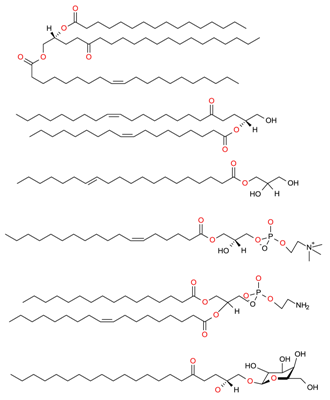 | UAE | Adam et al. [28] |
| Spirulina platensis | β-carotene |  | UAE | Dey and Rathod [29] |
| Fucus vesiculosus | Fucoidan |  | MAE | Hahn et al. [30], Cumashi et al. [31] |
| Streptomyces sp. | Bahamaolides A and B |  | Kim et al. [32] | |
| Chlorella vulgaris, Scenedesmus dimorphus, and Nannochloropsis sp. | Lipids | 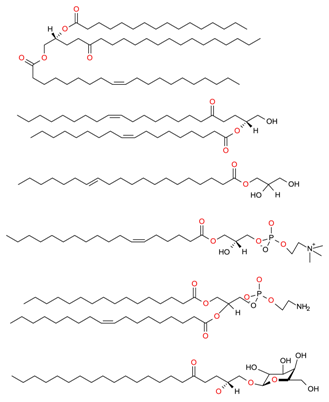 | EAE | Liang et al. [33] |
| Palmaria palmata | L-Ascorbic acid Glutathione |  | EAE | Wang et al. [34] |
| Sargassum muticum | Phenolic compounds | 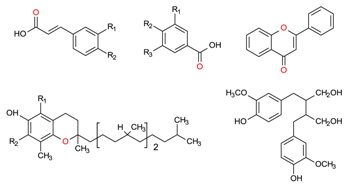 | EAE, MAE | Pérez et al. [35] |
| Laminaria and Saccharina species | Laminarin |  | Solvent extraction | Kadam et al. [36] |
| Dunaliella salina | Carotenoids (β-carotene) |  | PLE | Herrero et al. [37] |
| Phaeodactylum tricornutum | Fucoxanthin |  | PLE | Kim et al. [38] |
| Nannochloropsis sp. | Lipids | 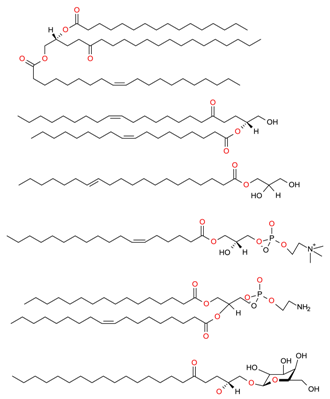 | EAE | Zuorro et al. [39] |
| Chlorella vulgaris | Lipids | 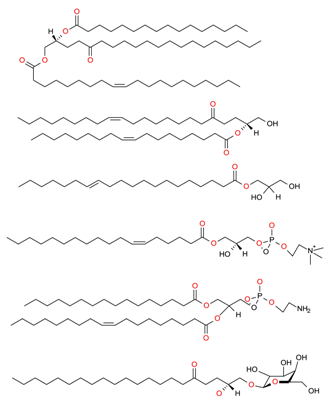 | MAE and SFE | Dejoye, et al. [40] |
| Chlorella vulgaris | Lutein |  | UAE | Deenu et al. [41] |
| Neochloris oleoabundans | Carotenoids (β-carotene) |  | PLE | Castro-Puyana et al. [42] |
| FA | FA (C:U) | RT (min) | F. vesiculosus | C. baccata | H. elongata | D. dichotoma | U. lactuca | U. intestinalis |
|---|---|---|---|---|---|---|---|---|
| FA content (mg/g algae) | FA 14:0 | 9.802 | 11.09 ± 0.19 | 5.13 ± 0.12 | 1.72 ± 0.04 | 3.01 ± 0.37 | 1.78 ± 0.22 | 1.96 ± 0.23 |
| FA 15:0 | 10.774 | 0.31 ± 0.03 | N.D | 0.17 ± 0.03 | N.D | 0.18 ± 0.02 | 0.08 ± 0.00 | |
| FA 16:1 | 11.789 | 0.98 ± 0.22 | 2.19 ± 0.04 | 0.56 ± 0.01 | 1.16 ± 0.05 | 0.16 ± 0.00 | 0.16 ± 0.00 | |
| FA 16:0 | 12.078 | 9.64 ± 0.30 | 6.80 ± 0.29 | 5.85 ± 0.14 | 4.40 ± 0.64 | 6.09 ± 0.29 | 6.02 ± 0.22 | |
| FA 18:3 | 14.900 | 0.08 ± 0.00 | N.D | 0.04 ± 0.04 | N.D | 0.09 ± 0.01 | N.D | |
| FA 18:2 | 15.304 | 0.34 ± 0.04 | 0.16 ± 0.02 | 0.01 ± 0.00 | 0.01 ± 0.00 | 0.05 ± 0.01 | 0.06 ± 0.00 | |
| FA 18:1 | 15.507 | 13.15 ± 1.03 | 3.09 ± 0.34 | 0.49 ± 0.09 | 1.09±0.05 | 0.47 ± 0.02 | 0.23 ± 0.01 | |
| FA 18:0 | 16.041 | 1.56 ± 0.13 | 1.65 ± 0.16 | 1.80 ± 0.04 | 1.28 ± 0.07 | 1.68 ± 0.11 | 2.11 ± 0.08 | |
| FA 20:4 | 20.549 | 1.30 ± 0.12 | 0.62 ± 0.01 | N.D | N.D | N.D | N.D | |
| FA 20:5 | 20.806 | 0.36 ± 0.08 | 0.24 ± 0.01 | N.D | 0.15 ± 0.03 | N.D | N.D | |
| FA total (mg/g algae) | 38.83 | 19.87 | 10.64 | 11.09 | 10.46 | 10.63 | ||
| Lipid content by Folch (%) | 6.6% | 6.7% | 6.0% | 5.7% | 4.8% | 4.6% | ||
© 2018 by the authors. Licensee MDPI, Basel, Switzerland. This article is an open access article distributed under the terms and conditions of the Creative Commons Attribution (CC BY) license (http://creativecommons.org/licenses/by/4.0/).
Share and Cite
Sosa-Hernández, J.E.; Escobedo-Avellaneda, Z.; Iqbal, H.M.N.; Welti-Chanes, J. State-of-the-Art Extraction Methodologies for Bioactive Compounds from Algal Biome to Meet Bio-Economy Challenges and Opportunities. Molecules 2018, 23, 2953. https://doi.org/10.3390/molecules23112953
Sosa-Hernández JE, Escobedo-Avellaneda Z, Iqbal HMN, Welti-Chanes J. State-of-the-Art Extraction Methodologies for Bioactive Compounds from Algal Biome to Meet Bio-Economy Challenges and Opportunities. Molecules. 2018; 23(11):2953. https://doi.org/10.3390/molecules23112953
Chicago/Turabian StyleSosa-Hernández, Juan Eduardo, Zamantha Escobedo-Avellaneda, Hafiz M. N. Iqbal, and Jorge Welti-Chanes. 2018. "State-of-the-Art Extraction Methodologies for Bioactive Compounds from Algal Biome to Meet Bio-Economy Challenges and Opportunities" Molecules 23, no. 11: 2953. https://doi.org/10.3390/molecules23112953
APA StyleSosa-Hernández, J. E., Escobedo-Avellaneda, Z., Iqbal, H. M. N., & Welti-Chanes, J. (2018). State-of-the-Art Extraction Methodologies for Bioactive Compounds from Algal Biome to Meet Bio-Economy Challenges and Opportunities. Molecules, 23(11), 2953. https://doi.org/10.3390/molecules23112953








